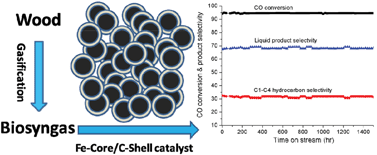Biochar, a by-product from the fast pyrolysis of pine wood, was used as the support material for the synthesis of carbon-encapsulated iron nanoparticles. The nanoparticles were characterized for physicochemical properties by multiple morphological and structural methods (e.g., SEM, TEM, XRD, FTIR, and TPD). The Fischer–Tropsch synthesis (FTS) process was carried out to evaluate the catalytic activity of the nanoparticles on conversion of biomass-derived synthesis gas (bio-syngas) to liquid hydrocarbons. Characterization results revealed that the nanoparticles had core–shell structures with iron in situ encapsulated within a graphitic shell. Moreover, significant amounts of iron carbide (mainly Fe3C) were formed as an interface between the carbonaceous shell and the iron core. FTS tests indicated that such carbon-encapsulated iron nanoparticles possessed a high activity on conversion of bio-syngas and good selectivity towards liquid hydrocarbons (of which olefins were the dominant product). Over a 1500 h testing period, the nanoparticles showed striking stability against deactivation, with CO conversion maintained at about 95% and liquid hydrocarbon selectivity at about 68%.

You have access to this article
 Please wait while we load your content...
Something went wrong. Try again?
Please wait while we load your content...
Something went wrong. Try again?


 Please wait while we load your content...
Please wait while we load your content...